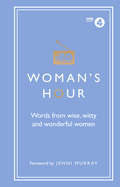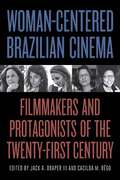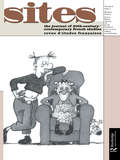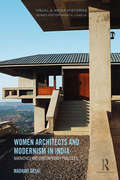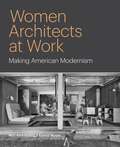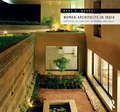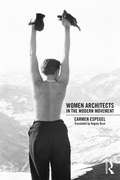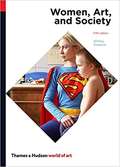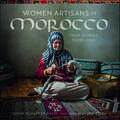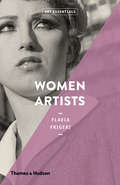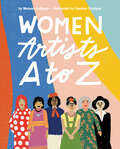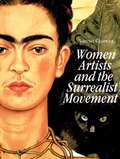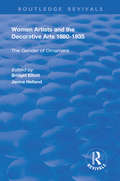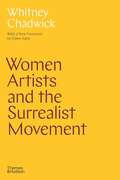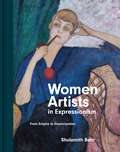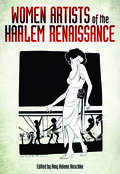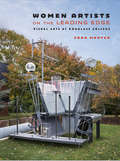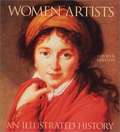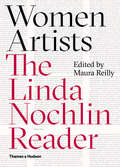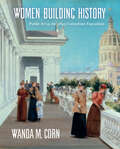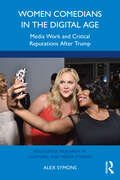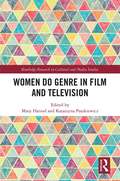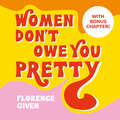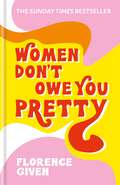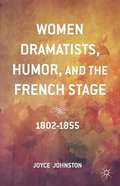- Table View
- List View
Woman's Hour: Words from Wise, Witty and Wonderful Women
by Alison MaloneyFor the last 70 years, the guests of Woman’s Hour have been entertaining listeners with their compelling combination of wit, warmth, insight and humour. Woman’s Hour has interviewed many of the biggest female names from entertainment, politics, the arts and beyond.Words from Wise, Witty and Wonderful Women is a collection of quotes and extracts from 70 years of the Woman’s Hour archive, featuring some of the most memorable guests to appear on the programme, from Doris Lessing to Nora Ephron, Hilary Clinton to J.K. Rowling, and Bette Davis to Meryl Streep. Charting the social and political revolution that has taken place in women’s lives over the past 70 years, as well as the perennial aspects of female life, such as love, family, relationships, the workplace, sex, ageing, and food, this delightful book shares fascinating insights and sage advice from the wise and wonderful women that have graced the Woman’s Hour airwaves over the decades.
Woman-Centered Brazilian Cinema: Filmmakers and Protagonists of the Twenty-First Century (SUNY series in Latin American Cinema)
by Jack A. Draper III Cacilda M. RêgoWoman-Centered Brazilian Cinema highlights the bold, inspiring, and diverse work of female filmmakers—including directors, screenwriters, and producers—and female protagonists in the twenty-first-century Brazilian film industry. This volume examines the diverse production and distribution spaces these filmmakers are working in, including documentary, experimental, and short filmmaking, as well as commercial feature films. An intersectional approach runs throughout the chapters with complex considerations around gender, race, sexuality, and class. The book features a mix of research methods and genres, with macro-level political, economic, and industry-wide views of gender disparities appearing alongside in-depth conversations with contemporary filmmakers Maria Augusta Ramos, Petra Costa, Mari Corrêa, and Paula Sacchetta, focused on micro-level personal experiences. In bringing together original essays and interviews, the volume provides valuable information for students of Brazil in general and of Brazilian film in particular.
Women
by Revue D’études FrançaisesPublished in 2001, Women is a valuable contribution to the field of Performance.
Women Architects and Modernism in India: Narratives and contemporary practices (Visual and Media Histories)
by Madhavi DesaiStudies on architecture in South Asia continue to ignore women in canonical histories of the discipline. This book attempts to recover the stories of the women architects whose careers nearly parallel the development of modernism in colonial and postcolonial India. Writing their experiences into the narrative of mainstream architectural history within the challenge of non-existent archives, it sheds light on seven pioneering women who broke male bastions to go beyond the traditional confines of the era from the 1940s onwards. The author also examines 28 contemporary practices to demonstrate the ways in which architectural modernism in India was shaped by the contribution of women. The book uses a format that weaves together social, professional and biographical factors into a productive account; pluralizes various concepts of design; and redefines the idea of ‘work’ of women through a greater range of activities, including pedagogy, mentoring and activism. Alluding to challenges faced by women, the study celebrates practices in diverse regional settings even as the designers move in transnational contexts in an increasingly globalizing India. Extensively illustrated, featuring drawings and photographs, this book will be a milestone in the modernist narrative of South Asia and will be of interest to scholars and researchers of architecture, gender studies, modern Indian history and sociology.
Women Architects at Work: Making American Modernism
by Mary Anne Hunting Kevin D. MurphyA comprehensive history of the women architects who left their enduring mark on American ModernismIn the decades preceding World War II, professional architecture schools enrolled increasing numbers of women, but career success did not come easily. Women Architects at Work tells the stories of the resilient and resourceful women who surmounted barriers of sexism, racism, and classism to take on crucial roles in the establishment and growth of Modernism across the United States.Mary Anne Hunting and Kevin D. Murphy describe how the Cambridge School of Architecture and Landscape Architecture in Massachusetts evolved for the professional education of women between 1916 and 1942. While alumnae such as Eleanor Agnes Raymond, Victorine du Pont Homsey, and Sarah Pillsbury Harkness achieved some notoriety, others like Elizabeth-Ann Campbell Knapp and Louisa Vaughan Conrad have been largely absent from histories of Modernism. Hunting and Murphy describe how these innovative practitioners capitalized on social, educational, and professional ties to achieve success and used architecture to address social concerns, including how modernist ideas could engage with community and the environment. Some joined women-led architectural firms while others partnered with men or contributed to Modernism as retailers of household furnishings, writers and educators, photographers and designers, or fine artists.With stunning illustrations, Women Architects at Work offers new histories of recognized figures while recovering the stories of previously unsung women, all of whom contributed to the modernization of American architecture and design.
Women Architects in India: Histories of Practice in Mumbai and Delhi
by Mary N. WoodsAs the first inclusive study of how women have shaped the modern Indian built environment from the independence struggle until today, this book reveals a history that is largely unknown, not only in the West, but also in India. Educated in the 1930s and 1940s, the very first women architects designed everything from factories to museums in the post-independence period. The generations that followed are now responsible for metro systems, shopping malls, corporate headquarters, and IT campuses for a global India. But they also design schools, cultural centers, religious pilgrimage hotels, and wildlife sanctuaries. Pioneers in conserving historic buildings, these women also sustain and resurrect traditional crafts and materials, empower rural and marginalized communities, and create ecologically sustainable architectures for India. Today, although women make up a majority in India’s ever-increasing schools of architecture, it is still not easy for them, like their Western sisters, to find their place in the profession. Recounting the work and lives of Indian women as not only architects, but also builders and clients, opens a new window onto the complexities of feminism, modernism, and design practice in India and beyond. Set in the design centers of Mumbai and Delhi, this book is also one of the first histories of architectural education and practice in two very different cities that are now global centers. The diversity of practices represented here helps us to imagine other ways to create and build apart from "starchitecture." And how these women negotiate tradition and modernity at work and at home is crucial for understanding gender and modern architecture in a more global and less Eurocentric context. In a country where female emancipation was important for narratives of the independence movement and the new nation-state, feminism was, nonetheless, eschewed as divisive and damaging to the nationalist cause. Class, caste, tradition, and family restricted—but also created—opportunities for the very first women architects in India, just as they do now for the growing number of young women professionals today.
Women Architects in the Modern Movement
by Carmen EspegelHeroines of Space looks at four groundbreaking women architects: Eileen Gray, Lilly Reich, Margarethe Schütte-Lihotzky, and Charlotte Perriand. You'll see the parts they played in the history of modern architecture and get a clearer view of the recent past. The book explains the social and historical setting behind their coming into being and includes research on the factors around their roles as space makers to show you how they practiced architecture despite pressure not to. New in English, the Spanish edition won the 2006 Milka Blinakov Prize granted by the International Archive of Women in Architecture. Includes 150 black and white images and bibliographies for each architect.
Women Art and Society
by Whitney ChadwickThe definitive work on the subject, mapping a complete history of women artists from the Middle Ages and the Renaissance to today <P><P> This acclaimed study challenges the assumption that great women artists are exceptions to the rule who “transcended” their sex to produce major works of art. While acknowledging the many women whose contributions to visual culture have often been neglected, Whitney Chadwick’s survey reexamines the works themselves and the ways in which they have been perceived as marginal, often in direct reference to gender. This revised edition features a new final chapter that charts the evolution of feminist art history and pedagogy since the 1970s. It is brought up to date with discussions of some of the most significant women artists to have emerged in recent years, including Wangechi Mutu, Jenny Saville, and Teresa Margolles. 332 illustrations, 124 in color
Women Artisans of Morocco: Their Stories, Their Lives
by Susan Schaefer DavisMorocco: Ancient cities, adobe fortresses of centuries past, fertile plains of wheat and olives, carpets of wildflowers, endless deserts, wild mountains, and isolated rural villages. And of course, the fabled open-air markets framed with stacks of woven rugs and other handicrafts, exotic scents wafting through the aisles, the hum of Arabic, Berber, French. Within this diverse land and confluence of cultures, many rich and ancient craft traditions carry on—women spin and weave, make buttons, embroider designs passed down through generations, and sew stunning native costumes. Women Artisans of Morocco tells the stories of twenty-five women who practice these textile traditions with an inspiring energy, pride, and fortitude. For the first time, we have a book that focuses on the artisans of Morocco themselves, those who produce these beautiful textiles that contribute substantially to their family's income while maintaining households and raising children. You will step into the lives of these Moroccan women artisans and gain an appreciation for their artistic skills and ingenuity but also for their strong roles in this supposedly male-dominated society, their fierce independence and determination as they work to improve their economic livelihoods. You will be welcomed into their homes in rural Berber villages, in bustling cities, and in a remarkable desert oasis. You will begin to learn truly what it is like to live as a woman in Morocco and to be part of a rapidly changing society. Most of the women presented here are rug weavers whose ancient skills and designs vary from region to region. You will also meet Fes embroidery artists, women who needle-weave buttons that have decorated native costumes for centuries, and a contemporary seamstress. Joe Coca's award-winning photography, guided by his curious and reverent sensibility, captures the beauty of the women, their work, and Morocco.
Women Artists (Art Essentials #0)
by Flavia FrigeriA chronological introduction to women artists throughout history, this book provides a rich understanding of key female artists from the Baroque to the present day. In 1971, in an essay that has now become one of the touchstones of feminist art history, Linda Nochlin raised the question heard round the world: “Why have there been no great women artists?” Since the 1970s, as a result of this kind of consciousness-raising, the feminist discourse around art has expanded, addressing forms of activism, the idea of a feminist aesthetic, the female body, sexuality, and representation more largely. The reframing of female contributions to the history of art is still ongoing, and this new addition to the Art Essentials series draws attention to some of its key dimensions. Focusing on fifty diverse women artists from Artemisia Gentileschi through Judy Chicago, Ana Mendieta, and the Guerrilla Girls to Barbara Kruger, Cindy Sherman, and Mona Hatoum, this book equips readers with an understanding of feminist art, as well as an appreciation of its most important figures. This latest addition to the Art Essentials series documents women artists in context to offer readers a rich understanding of key female artists from the Baroque to the present day.
Women Artists A to Z
by Melanie LaBargeAn empowering and educational alphabet picture book about women artists, perfect for fans of Rad American Women A-Z.How many women artists can you name? From Frida Kahlo and Georgia O'Keeffe, to Jaune Quick-to-See Smith and Xenobia Bailey, this lushly illustrated alphabet picture book presents both famous and underrepresented women in the fine arts from a variety of genres: painting, drawing, sculpture, photography, and more. Each spread features a simple line of text encapsulating the creator's iconic work in one word, such as "D is for Dots" (Yayoi Kusama) and "S is for Spider" (Louise Bourgeois), followed by slightly longer text about the artist for older readers who would like to know more. Backmatter includes extended biographies and discussion questions for budding creatives and trailblazers. Artists featured: Mirka Mora, Betye Saar, Helen Frankenthaler, Yayoi Kusama, Kay Sage, Georgia O'Keeffe, Agnes Martin, Jaune Quick-to-See Smith, Elizabeth Catlett, Judith Leyster, Leonora Carrington, Carmen Herrera, Edmonia Lewis, Maya Lin, Hilma af Klint, Maria Martinez, Gee's Bend quilters, Frida Kahlo, Louise Bourgeois, Loïs Mailou Jones, Alice Neel, Helen Zughaib, Ursula von Rydingsvard, Dorothea Lange, Xenobia Bailey, and Maria Sibylla Merian.
Women Artists And The Surrealist Movement
by Whitney ChadwickThis pioneering book stands as the most comprehensive treatment of the lives, ideas and art works of the remarkable group of women who were an essential part of the Surrealist movement.
Women Artists and the Decorative Arts 1880-1935: The Gender of Ornament (Routledge Revivals Ser.)
by Janice HellandThis title was first published in 2002. To date, studies explaining decorative practice in the early modernist period have largely overlooked the work of women artists. For the most part, studies have focused on the denigration of decorative work by leading male artists, frequently dismissed as fashionably feminine. With few exceptions, women have been cast as consumers rather than producers. The first book to examine the decorative strategies of late nineteenth- and early twentieth-century women artists, Women Artists and the Decorative Arts concentrates in particular on women artists who turned to fashion, interior design and artisanal production as ways of critically engaging various aspects of modernity. Women artists and designers played a vital role in developing a broad spectrum of modernist forms. In these essays new light is shed on the practice of such well-known women artists as May Morris, Clarice Cliff, Natacha Rambova, Eileen Gray and Florine Stettheimer, whose decorative practices are linked with a number of fascinating but lesser known figures such as Phoebe Traquair, Mary Watts, Gluck and Laura Nagy.
Women Artists and the Surrealist Movement
by Whitney ChadwickA revised edition of Whitney Chadwick’s seminal work on the women artists who shaped the Surrealist art movement. This pioneering book stands as the most comprehensive treatment of the lives, ideas, and art works of the remarkable group of women who were an essential part of the Surrealist movement. Leonora Carrington, Frida Kahlo, and Dorothea Tanning, among many others, embodied their age as they struggled toward artistic maturity and their own “liberation of the spirit” in the context of the Surrealist revolution. Their stories and achievements are presented here against the background of the turbulent decades of the 1920s, ’30s, and ’40s and the war that forced Surrealism into exile in New York and Mexico. Whitney Chadwick, author of the highly acclaimed Women, Art, and Society, interviewed and corresponded with most of the artists themselves in the course of her research. Women Artists and the Surrealist Movement, now revised with a new foreword by art historian Dawn Ades, contains a wealth of extracts from unpublished writings and numerous illustrations never before reproduced. Since this book was first published, it has acquired the undeniable status of a classic among artists, art historians, critics, and cultural historians. It has inspired and necessitated a revision of the story of the Surrealist movement.
Women Artists in Expressionism: From Empire to Emancipation
by Shulamith BehrA beautifully illustrated examination of the women artists whose inspired search for artistic integrity and equality influenced Expressionist avant-garde cultureWomen Artists in Expressionism explores how women negotiated the competitive world of modern art during the late Wilhelmine and early Weimar periods in Germany. Their stories challenge predominantly male-oriented narratives of Expressionism and shed light on the divergent artistic responses of women to the dramatic events of the early twentieth century.Shulamith Behr shows how the posthumous critical reception of Paula Modersohn-Becker cast her as a prime agent of the feminization of the movement, and how Käthe Kollwitz used printmaking as a vehicle for technical innovation and sociopolitical commentary. She looks at the dynamic relationship between Marianne Werefkin and Gabriele Münter, whose different paths in life led them to the Blaue Reiter, a group of Expressionist artists that included Wassily Kandinsky and Paul Klee. Behr examines Nell Walden’s role as an influential art dealer, collector, and artist, who promoted women Expressionists during the First World War, and discusses how Dutch artist Jacoba van Heemskerck’s spiritual abstraction earned her the status of an honorary German Expressionist. She demonstrates how figures such as Rosa Schapire and Johanna Ey contributed to the development of the movement as spectators, critics, and collectors of male avant-gardism.Richly illustrated, Women Artists in Expressionism is a women-centered history that reveals the importance of emancipative ideals to the shaping of modernity and the avant-garde.
Women Artists of the Harlem Renaissance
by Amy Helene KirschkeWomen artists of the Harlem Renaissance dealt with issues that were unique to both their gender and their race. They experienced racial prejudice, which limited their ability to obtain training and to be taken seriously as working artists. They also encountered prevailing sexism, often an even more serious barrier. Including seventy-two black-and-white illustrations, this book chronicles the challenges of women artists, who are in some cases unknown to the general public, and places their achievements in the artistic and cultural context of early twentieth-century America. Contributors to this first book on the women artists of the Harlem Renaissance proclaim the legacy of Edmonia Lewis, Meta Vaux Warrick Fuller, Augusta Savage, Selma Burke, Elizabeth Prophet, Lois Maillou Jones, Elizabeth Catlett, and many other painters, sculptors, and printmakers. In a time of more rigid gender roles, women artists faced the added struggle of raising families and attempting to gain support and encouragement from their often-reluctant spouses in order to pursue their art. They also confronted the challenge of convincing their fellow male artists that they, too, should be seen as important contributors to the artistic innovation of the era.
Women Artists on the Leading Edge: Visual Arts at Douglass College
by Joan M. MarterHow do students develop a personal style from their instruction in a visual arts program? Women Artists on the Leading Edge explores this question as it describes the emergence of an important group of young women artists from an innovative post-war visual arts program at Douglass College. The women who studied with avant-garde artists at Douglas were among the first students in the nation to be introduced to performance art, conceptual art, Fluxus, and Pop Art. These young artists were among the first to experience new approaches to artmaking that rejected the predominant style of the 1950s: Abstract Expressionism. The New Art espoused by faculty including Robert Watts, Allan Kaprow, Roy Lichtenstein, Geoffrey Hendricks, and others advocated that art should be based on everyday life. The phrase “anything can be art” was frequently repeated in the creation of Happenings, multi-media installations, and video art. Experimental approaches to methods of creation using a remarkable range of materials were investigated by these young women. Interdisciplinary aspects of the Douglass curriculum became the basis for performances, videos, photography, and constructions. Sculpture was created using new technologies and industrial materials. The Douglass women artists included in this book were among the first to implement the message and direction of their instructors. Ultimately, the artistic careers of these young women have reflected the successful interaction of students with a cutting-edge faculty. From this BA and MFA program in the Visual Arts emerged women such as Alice Aycock. Rita Myers, Joan Snyder, Mimi Smith, and Jackie Winsor, who went on to become lifelong innovators. Camaraderie was important among the Douglass art students, and many continue to be instructors within a close circle of associates from their college years. Even before the inception of the women’s art movement of the 1970s, these women students were encouraged to pursue professional careers, and to remain independent in their approach to making art. The message of the New Art was to relate one’s art production to life itself and to personal experiences. From these directions emerged a “proto-feminist” art of great originality identified with women’s issues. The legacy of these artists can be found in radical changes in art instruction since the 1950s, the promotion of non-hierarchical approaches to media, and acceptance of conceptual art as a viable art form.
Women Artists: An Illustrated History (Revised and Expanded)
by Nancy G. HellerWith coverage of the 1990s and the beginning of the new millennium, nearly half of the fourth edition of this history is devoted to the remarkable period from 1960 to the modern day when women artists emerged as the most dynamic force in contemporary art. New to this edition are innovative contemporary American artists, such as Janine Antoni and Renee Cox, as well as major international figures, including Iran's Shirin Neshat, Shahzia Sikander from Pakistan and the Icelandic sculptor and performance artist Katrin Sigurdardottir.
Women Artists: The Linda Nochlin Reader
by Maura Reilly Linda NochlinThe first comprehensive anthology of art historian Linda Nochlin's work, including her landmark essays on the position and influence of women artists Linda Nochlin is one of the most accessible, provocative, and innovative art historians of our time. In 1971 she published her essay "Why Have There Been No Great Women Artists?"--a dramatic feminist call-to-arms that called traditional art historical practices into question and led to a major revision of the discipline. Women Artists brings together twenty-nine essential essays from throughout Nochlin's career, making this the definitive anthology of her writing about women in art. Included are her major thematic texts "Women Artists After the French Revolution" and "Starting from Scratch: The Beginnings of Feminist Art History," as well as the landmark essay and its rejoinder "'Why Have There Been No Great Women Artists?' Thirty Years After." These appear alongside monographic entries focusing on a selection of major women artists including Mary Cassatt, Louise Bourgeois, Cecily Brown, Kiki Smith, Miwa Yanagi, and Sophie Calle. Women Artists also presents two new essays written specifically for this book and an interview with Nochlin investigating the position of women artists today.
Women Building History: Public Art at the 1893 Columbian Exposition
by Wanda CornThis handsomely illustrated book is a welcome addition to the history of women during America’s Gilded Age. Wanda M. Corn takes as her topic the grand neo-classical Woman’s Building at the 1893 Columbian Exposition in Chicago, a structure celebrating modern woman’s progress in education, arts, and sciences. Looking closely at the paintings and sculptures women artists made to decorate the structure, including the murals by Mary Cassatt and Mary MacMonnies, Corn uncovers an unspoken but consensual program to visualize a history of the female sex and promote an expansion of modern woman’s opportunities. Beautifully written, with informative sidebars by Annelise K. Madsen and artist biographies by Charlene G. Garfinkle, this volume illuminates the originality of the public images female artists created in 1893 and inserts them into the complex discourse of fin de siècle woman’s politics. The Woman’s Building offered female artists an unprecedented opportunity to create public art and imagine an historical narrative that put women rather than men at its center.
Women Comedians in the Digital Age: Media Work and Critical Reputations After Trump (Routledge Research in Cultural and Media Studies)
by Alex SymonsThis book offers a thorough examination of digital work by women comedians in the US, exploring their use of digital media to perform jokes, engage with fans, remake their reputations, and become political activists. This book argues that despite its many adverse effects, digital work is changing comedy, empowering women to create new comic forms and negotiate the contentious political climate incited by former President Donald. J. Trump. Chapters are focused on video podcasting, TikTok, Twitter, Instagram, YouTube, and the streaming platform Netflix – each containing informative case studies on significant women comedians who use them, including Sarah Silverman, Amy Schumer, Leslie Jones, Mindy Kaling, Colleen Ballinger, Lilly Singh, Ms. Pat, Whitney Cummings, Issa Rae, and others. To understand their strategies, this book examines the popularity of their digital content, their career outcomes in television and film, as well as the ups and downs of their critical reputations in magazines, newspapers, the trade press, and with their participatory audiences online. This insightful and timely work will appeal to scholars researching and teaching in the areas of media studies, digital communication, gender studies, and performance.
Women Do Genre in Film and Television (Routledge Research in Cultural and Media Studies)
by Katarzyna Paszkiewicz Mary HarrodThis volume examines how different generations of women work within the genericity of audio-visual storytelling not necessarily to ‘undo’ or ‘subvert’ popular formats, but also to draw on their generative force. Recent examples of filmmakers and creative practitioners within and outside Hollywood as well as women working in non-directing authorial roles remind us that women are in various ways authoring commercially and culturally impactful texts across a range of genres. Put simply, this volume asks: what do women who are creatively engaged with audio-visual industries do with genre and what does genre do with them? The contributors to the collection respond to this question from diverse perspectives and with different answers, spanning issues of direction, screenwriting, performance and audience address/reception.
Women Don't Owe You Pretty: The debut book from Florence Given
by Florence Given'THE BEAUTY MYTH' FOR THE INSTAGRAM GENERATIONWomen Don't Owe You Pretty is the ultimate book for anyone who wants to challenge the out-dated narratives supplied to us by the patriarchy.Through Florence's story you will learn how to protect your energy, discover that you are the love of your own life, and realise that today is a wonderful day to dump them.Florence Given is here to remind you that you owe men nothing, least of all pretty.WARNING: CONTAINS EXPLICIT CONTENT (AND A LOAD OF UNCOMFORTABLE TRUTHS). THE FEMINIST BOOK EVERYONE IS TALKING ABOUT.'An incredible mouthpiece for modern intersectional feminism.' - Glamour'A fearless book.' - Cosmopolitan 'A hugely influential young woman.' - Woman's Hour 'Rallying, radical and pitched perfectly for her generation.' - Evening StandardThis audiobook was recorded from home in May 2020. (P)2020 Octopus Publishing Group
Women Don't Owe You Pretty: The record-breaking best-selling book every woman needs
by Florence Given'THE BEAUTY MYTH' FOR THE INSTAGRAM GENERATIONWomen Don't Owe You Pretty is the ultimate book for anyone who wants to challenge the out-dated narratives supplied to us by the patriarchy.Through Florence's story you will learn how to protect your energy, discover that you are the love of your own life, and realise that today is a wonderful day to dump them.Florence Given is here to remind you that you owe men nothing, least of all pretty.WARNING: CONTAINS EXPLICIT CONTENT (AND A LOAD OF UNCOMFORTABLE TRUTHS). THE FEMINIST BOOK EVERYONE IS TALKING ABOUT.'An incredible mouthpiece for modern intersectional feminism.' - Glamour'A fearless book.' - Cosmopolitan 'A hugely influential young woman.' - Woman's Hour 'Rallying, radical and pitched perfectly for her generation.' - Evening Standard
Women Dramatists, Humor, and the French Stage
by Joyce JohnstonFilling a critical void, this book examines French women dramatists of the nineteenth century who managed to have their works staged prior to the lifting of censorship laws in 1864. Sophie de Bawr (1773 1860), Sophie Gay (1776 1852), Virginie Ancelot (1792 1875), and Delphine Gay de Girardin (1804 1855) all staged successful plays at Paris's top venues (Theatre Francais and Odeon) or at other selective theatres (Ambigu-Comique, Vaudeville, Gymnase) during this period without the aid or protection of a male coauthor. Between 1802 and 1855, all four of these dramatists were heavily involved in the literary scene of their day and hosted their own salons, venues essential for any male author wishing to see his works published and accepted among the public. While not always directly engaged in the politics of the day in their theater, these dramatists were aware of and influenced by the public sphere. Though none staged what today's critics would refer to as overtly feminist drama, through their use of humor, Bawr, Gay, Ancelot, and Girardin all cast aspersion upon patriarchal dominance and reconstructed ideals of womanhood that rejected traditional submissive roles. "
